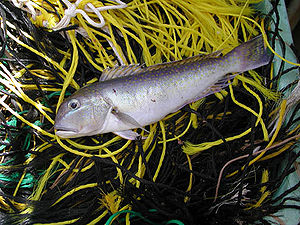Brick perch
| Brick perch | ||||||||||||
|---|---|---|---|---|---|---|---|---|---|---|---|---|

Brick perch ( Lopholatilus chamaeleonticeps ) |
||||||||||||
| Systematics | ||||||||||||
|
||||||||||||
| Scientific name | ||||||||||||
| Lopholatilus chamaeleonticeps | ||||||||||||
| Goode & Bean , 1879 | ||||||||||||

The brick perch ( Lopholatilus chamaeleonticeps ), also known as blue brick fish , brick fish or blue brick perch , is a species of fish from the subfamily of brick perch in the family of torpedo perch (Malacanthidae), which includes very few species .
features
It reaches 1.25 m in length and up to 30 kg in weight, but these dimensions only apply to males, females remain smaller. The animals reach an age of 35 years. It is characterized by a triangular skin flap in front of the dorsal fin, which is larger in the male than in the female. The gill cover is reinforced with a thorn. There is a little barb at the corner of each mouth . The coloring is quite colorful. The top of the head and the back are brownish to violet and spotted with dark yellow scales; the sides are silvery, the fins yellowish to purple. The head sides are mostly blue. The scale spines are quite large, which makes the fish look rough.
The fin formula is D VII – VIII / 14–15, AI / 13–14, P 16–18, VI / 5.
Way of life
The species prefers sandy or muddy bottom at a depth of approx. 200 m, but occurs in an area from 20 to over 500 m deep. The animals inhabit the North American continental shelf from Canada to the eastern Gulf of Mexico and live here in small groups close to the bottom of invertebrates, especially crustaceans and smaller fish. It seems that every fish digs a living ("sleeping"?) Cave. The preferred temperature is 8–17 ° C. The eggs are released in small portions over months, a total of up to 200,000 per season and female, and develop pelagically into prickly larvae in the warmer seasons .
Existence and endangerment
Before 1879 it was apparently completely unknown; In the following years it quickly became popular due to longline fishing and was soon well known to fishermen from Nova Scotia to Pennsylvania, but suddenly disappeared from the catch in 1882. Apparently an advance of the cold Labrador Current had triggered a mass extinction, huge numbers of dead fish drifted to the coasts. The recovery was slow and varied; very often he no longer became. Nevertheless, it is a popular table and fishing fish.
Systematics
The malacanthids are difficult to define and are now considered an artificial unit of Brachiostegidae and Latilidae . From Lopholatilus there is the related species L. villarii Miranda Ribeiro 1915 on the South American east coast (as far as Uruguay) , but it is not known whether it can be clearly distinguished from L. chamaeleonticeps ; the assignment of animals from the Caribbean is unclear.
literature
- HB Bigelow and WC Schroeder (1953, rev. 2001): The fishes of the Gulf of Maine. Fish. Bull. Fish. Wildl. Serv. 53: pp. 426-431.
Individual evidence
- ↑ Theodor CH Cole: Dictionary of food. Spektrum Akademischer Verlag, 2010, ISBN 978-3-8274-1992-7 , p. 227.
- ↑ Common names of Lopholatilus chamaeleonticeps at www.fishbase.org
Web links
- Brick perch on Fishbase.org (English)